engine MERCEDES-BENZ SPRINTER 2019 MY19 with no MMS Operator’s Manual
[x] Cancel search | Manufacturer: MERCEDES-BENZ, Model Year: 2019, Model line: SPRINTER, Model: MERCEDES-BENZ SPRINTER 2019Pages: 322, PDF Size: 5.91 MB
Page 130 of 322

&
WARNING Risk of accident whe nswitch‐
ing of fthe ignition when driving
If yo us wit ch offt he ignition while driving,
saf etyf unction sare re stricted or no longer
av ailable. This ma yaffect thep owersteering
sy stem and theb rake forc eb oosting, for
ex ample.
Yo uw illthen need touse considerabl ymore
fo rc etos teer and brake. #
Do no tswitc hoffthei gnition while driv‐
ing. &
DANG ER Risk of fata linjuries due to
ex haus tgases
Combustio nengines emit poisonous exhaust
ga ses suc hascarbon monoxide. Inhaling
th ese exhaus tgases is hazardou stohealth
and can lead topoisoning. #
Neverlea ve thee ngine running in an
enclose dspace wi thout suf ficient venti‐
lation. &
DANG ER Risk of fata linjur ydue topoi‐
sonous exhaus tgases
If th et ailpipe is bloc kedors ufficient ventila‐
tion is no tpossible ,poisonous exhaus tgases
suc hasc arbon monoxide ma yenter thev ehi‐
cle. This is thec ase if thev ehicle getsstuck
in sno w,fore xamp le. #
Keep thet ailpipe and thea reaa round
th ev ehicle free from sno wwhen the
engine or thes tationar yheater ar erun‐
ning. #
Open awindo wont he windwar dside of
th ev ehicle toensur eana dequat esup‐
ply of fresh air. &
WARNING Risk of accident and inju ry
due tobeing under thei nfluence of alco‐
hol and drugs while driving
Driving when under thei nfluence of alcohol
and/or drugs is an extreme lydangerous com‐
bination .Evens mall quantitie sofalcohol or
drugs ma yaffect your reflexe s, perception
and judgment.
The probability of aserious or evenfatal acci‐
dent greatl yinc reases if youd rive when
unde rthe influence of alcohol or drugs. #
Do no tdrink alcohol or take drugs while
driving, and do no tallowa nyone todrive who has been drinkin
galcohol or taking
drugs. &
WARNING Risk of accident and injury
from ope rating mobil ecommunications
equipment
If yo uo perat emobile communication equip‐
men twhen driving, youw ill be distracted
from thet raffic situation .Thisc ould also
cause youtol ose control of thev ehicle.
The probability of aserious or evenfatal acci‐
dent inc reases greatl yifyou operat emobile
communication equipment when driving. #
Only operat emobile communication
equipment when thev ehicle is station‐
ar y. Fo
ry our owns afet y, alwa ys obser vethef ollowing
points when operating mobile communications
equipment:
R Obser vethel egal requ irements fort he coun‐
tr yinw hichyou ar edriving.
R While driving, on lyoperat emobile communi‐
cations equipment when thet raffic conditions
permit it. Youm ayotherwise be distracted
from thet raffic condition sand cause an acci‐
dent, inju ring yourself and others. &
WARNING Risk of accident du etoover‐
heated brak esystem
If yo ur esty our foot on theb rake pedal during
while driving, theb rake system ma yoverheat.
This increases theb raking dis tance and the
brak esystemm ayeve nfail. #
Neveru se theb rake pedal as afootrest. #
Do no tpress theb rake pedal and accel‐
erator pedal simultaneously while driv‐
ing. On long and
steep downhill gradients, yous hould
ch ang edowntoa lowe rgear in good time. Take
particular no teofthis when driving aladen vehi‐
cle. By doing so, youw ill mak euse of the
engine' sbraking ef fect. Thi srelie vest he load on
th eb rake system and pr events theb rake sf rom
ove rheating and wearing tooq uickl y. 106
Driving and pa rking
Page 131 of 322
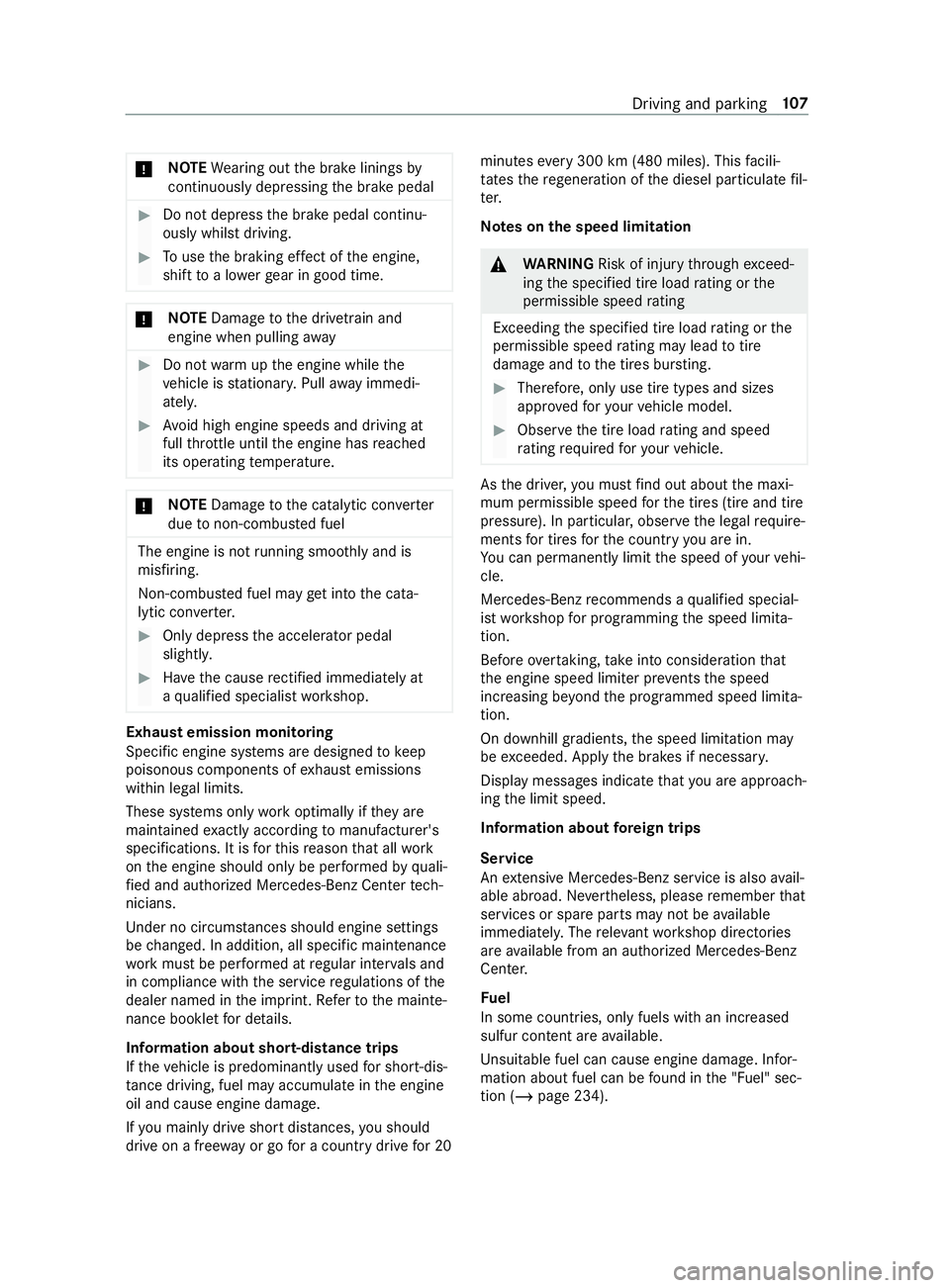
*
NO
TEWearing out theb rake linings by
continuously dep ressing theb rake pedal #
Do no tdepress theb rake pedal continu‐
ously whils tdriving. #
Touse theb raking ef fect of thee ngine,
shif ttoa lowe rgear in good time. *
NO
TEDama getothed rive trai nand
engin ewhen pulling away #
Do no twarmupt he engine while the
ve hicle is stationar y.Pull away immedi‐
atel y. #
Avoid high engine speeds and driving at
full thro ttle unti lthe engine has reached
its operatin gtemperature. *
NO
TEDama getothec atalytic con verter
due tonon-combu sted fuel The engine is no
trunnin gsmo othly and is
misfiring.
Non-combus tedf uel ma ygetintot he cata‐
lytic con verter. #
Onlydepress thea ccelera torp edal
slightly. #
Have thec ause rectified immedia tely at
aq ualifie dspecialis tworks hop. Exhaus
temission monitoring
Specific engine sy stems ar edesigned tokeep
poisonous components of exhaus temissions
within legal limits.
These sy stems onl yworko ptimally if they are
main tained exactly according tomanufacturer's
specifications. It is fort his reason that all work
on thee ngine should onl ybeperform ed byquali‐
fi ed and authorized Mercedes-Benz Center tech‐
nicians.
Under no circum stances shoul dengine settings
be changed. In addition ,all specific main tenance
wo rkmus tbep erform ed at regular inter vals and
in complianc ewitht he service regulations of the
dealer named in thei mp rint. Refe rtot he mainte‐
nance bookle tfor de tails.
Information about short-distance trips
If th ev ehicle is predominantl yused fors hort-dis‐
ta nce driving, fue lmayaccumulat einthe engine
oil and cause engine damage.
If yo um ainlydriv eshor tdista nces, yous hould
driv eonaf reew ay or go forac ountr ydrive for20 minutes
every300 km (480 miles). This facili‐
ta test he rege neration of thed iesel particulat efil‐
te r.
Note sont he speed limitation &
WARNING Risk of inju rythro ugh exceed‐
ing thes pecified tir eload rating or the
permissible speed rating
Exceeding thes pecified tir eload rating or the
permissible speed rating ma ylea dtot ire
dama geand tothet ires bur sting. #
Therefore, onl yuse tir etypes and sizes
appr ovedfor your vehicle model. #
Obser vethet irel oad rating and speed
ra ting requ ired fory our vehicle. As
thed rive r,yo um ustfind out about them axi‐
mum permissible speed fort he tires (tir eand tire
pressure). In particular ,obser vethel egal requ ire‐
ments fort ires fort he countr yyou ar ein.
Yo uc an permanently limit thes peed of your vehi‐
cle.
Mercedes-Benzr ecommendsaqualified special‐
is tw orks hop forp rogramming thes peed limita‐
tion.
Befor eovertaking, take intoc onsideration that
th ee ngine speed limiter pr events thes peed
increasing be yond thep rogrammed speed limita‐
tion.
On downhill gradients, thes peed limitation may
be exc eeded. Appl ythe brakes if necessar y.
Displ aymessages indica tethat youa reapproach‐
ing thel imit speed.
Information about fore ign trips
Service
An extensiv eMercedes-Benz service is also avail‐
able abroad. Ne vertheless, please remember that
services or spar eparts ma ynotbe available
immediatel y.The releva nt wo rkshop directories
ar ea vailable from an authorize dMercedes-Benz
Center.
Fu el
In some countries, onl yfuels wit hanincreased
sulfur con tent ar eavailable.
Uns uitable fuel can caus eengine damage. In for‐
mation abou tfuel can be found in the" Fuel" sec‐
tion (/ page234). Driving and parking
107
Page 132 of 322
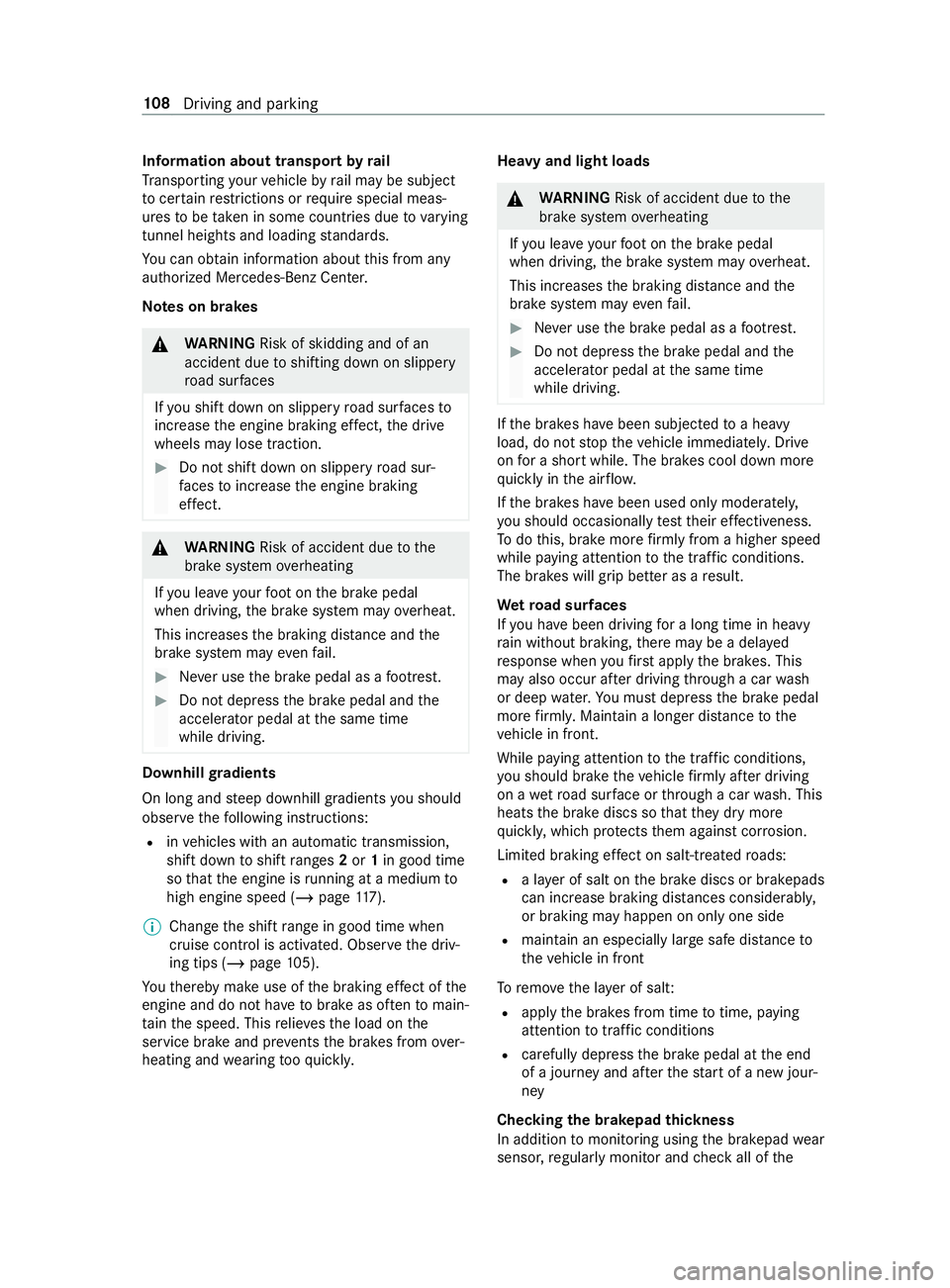
Information abou
ttranspor tbyrail
Tr ansportin gyour vehicle byrail ma ybes ubject
to cer tain restrictions or requ ires pecial meas‐
ures tobe take nins omecountrie sdue tovarying
tunnel height sand loading standards.
Yo uc an obtain information about this from any
authorized Mercedes-Benz Center.
Note sonb rakes &
WARNING Risk of skidding and of an
accident du etoshifting down on slippery
ro ad sur faces
If yo us hiftd ow nons lipperyroad sur faces to
inc rease thee ngine braking ef fect, thed rive
wheels ma ylose traction. #
Do no tshif td ow nons lipperyroad sur‐
fa ces toinc rease thee ngine braking
ef fect. &
WARNING Risk of accident du etothe
brak esystem overheating
If yo ul eave your foot on theb rake pedal
when driving, theb rake system ma yoverheat.
This increases theb raking dis tance and the
brak esystemm ayeve nfail. #
Neveru se theb rake pedal as afootrest. #
Do no tdepress theb rake pedal and the
accelerator pedal at thes ame time
while driving. Downhill
gradients
On long and steep downhill gradients yous hould
obse rvet he following instructions:
R invehicles wit hanautomatic transmission,
shif tdow ntos hiftranges 2or 1in good time
so that thee ngine is running at amediu mto
high engine speed (/ page117).
% Cha
nget he shif trang eing oodt ime when
cruise control is acti vated. Obser vethed riv‐
ing tips (/ page105).
Yo ut hereb ymakeu se of theb raking ef fect of the
engine and do no thave tobrak easo ften tomain‐
tai nt he speed. This relie vest he load on the
service brak eand pr events theb rake sf romo ver‐
heating and wearing tooq uickl y. Heavy and light loads &
WARNING Risk of accident du etothe
brak esystemo verheating
If yo ul eave your foot on theb rake pedal
when driving, theb rake system ma yoverheat.
This increases theb raking dis tance and the
brak esystemm ayeve nfail. #
Neveru se theb rake pedal as afootrest. #
Do no tdepress theb rake pedal and the
accelerator pedal at thes ame time
while driving. If
th eb rake sh aveb een subjected toah eavy
load, do no tstopt he vehicle immediately .Drive
on foras hortwhile. The brakes cool down more
qu ickl yint he air flow.
If th eb rake sh aveb een used onl ymoderatel y,
yo us houl doccasionall ytesttheir ef fectiveness.
To do this, brak emoref irml yfromah igher speed
while paying attention tothet raffic conditions.
The brakes will grip better as aresult.
We troad sur faces
If yo uh ave been driving foral ong time in heavy
ra in without braking, ther em aybe adelayed
re sponse when youf irst apply theb rake s. This
ma yalso occur af terd riving thro ugh acarwa sh
or deep water.Yo um ustd epress theb rake pedal
mor efirml y.Main tainal ongerd ista nc etot he
ve hicle in front.
While paying attention tothet raffic conditions,
yo us houl dbrakethe vehicle firm ly af terd riving
on aw etroad sur face or thro ugh acarwa sh. This
heats theb rake discs so that they drym ore
qu ickl y,whic hprotects them agains tcorrosion.
Limited braking ef fect on salt-trea tedr oads:
R alayer of salt on theb rake discs or brakepads
can increase braking dis tances conside rably,
or braking ma yhappen on onl yone side
R maintain an especiall ylarge safed ista nce to
th ev ehicle in front
To remo vethel aye rofs alt:
R apply theb rake sf romt ime totime ,paying
attention totraf ficc onditions
R carefully dep ress theb rake pedal at thee nd
of ajourne yand af tert he star tofan ewjour‐
ney
Checking theb rake pa dt hickness
In addition tomonitoring using theb rake pad wear
sensor ,regular lymonitor and checka ll of the 108
Driving and pa rking
Page 133 of 322
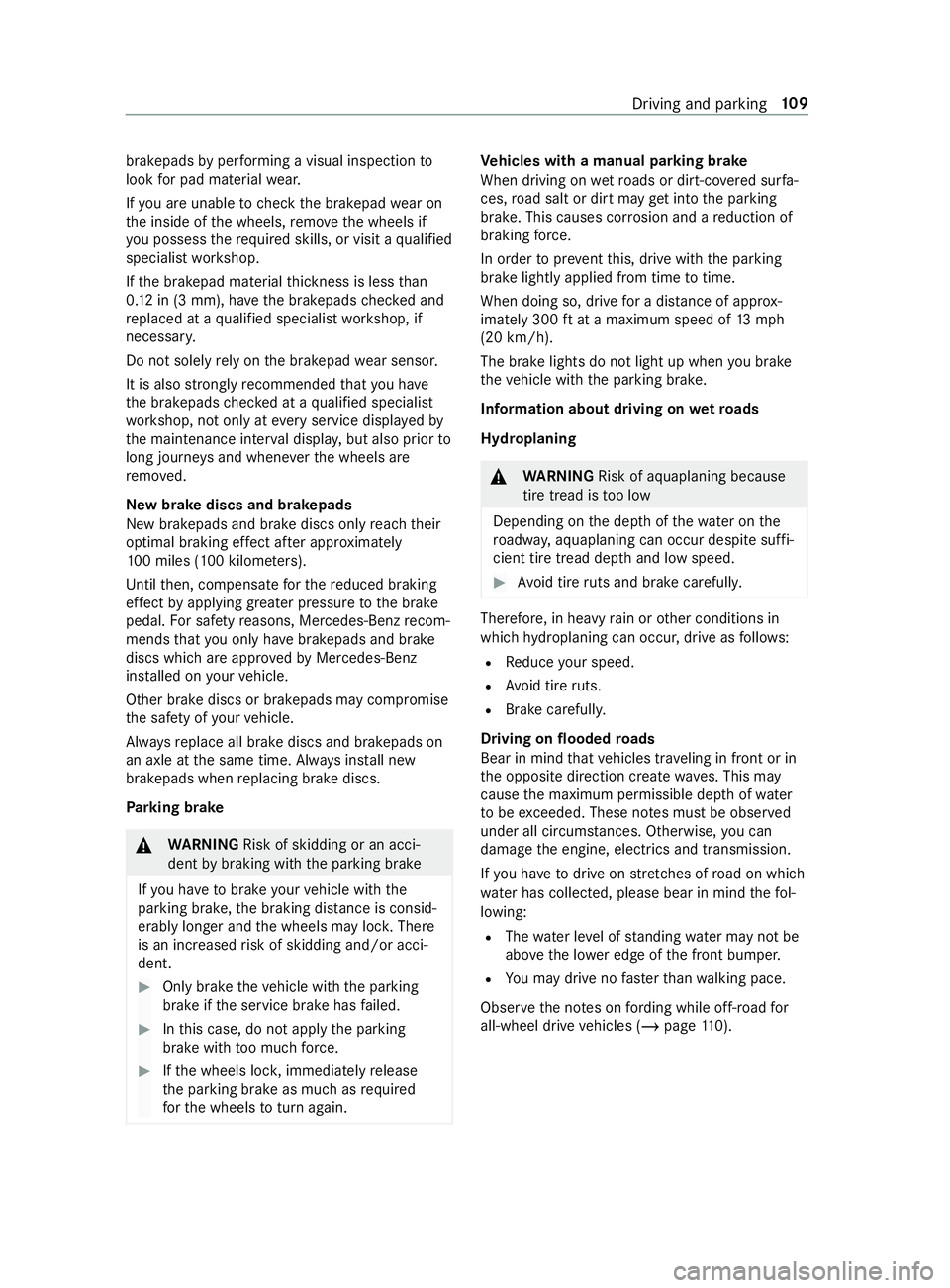
brakepads
byper form ing avisual inspection to
look forp ad material wear.
If yo ua reunabl etoc heckthe brakepad wear on
th ei nside of thew heels, remo vethew heels if
yo up ossess ther equired skills, or visit aqualified
specialis tworks hop.
If th eb rake pad material thickness is less than
0. 12 in (3 mm), ha vetheb rake pads checkeda nd
re placed at aqualified specialis tworks hop, if
necessar y.
Do no tsolely rely on theb rake pad wear sensor.
It is also strongly recommended that youh ave
th eb rake pads checkedataq ualified specialist
wo rkshop, no tonly at everyservice displa yedby
th em aintenanc einter vald ispla y,but also prior to
long journe ysand when ever thew heels are
re mo ved.
Ne wb rake discs and brakepads
Ne wb rakepads and brak ediscso nly reac ht heir
optimal braking ef fect af tera pproxima tely
10 0m iles( 10 0k ilome ters).
Unti lthen, compensat efor ther educed braking
ef fect by applying greater pressur etothe brake
pedal. Fors afet yr easons, Mercedes-Benz recom‐
mends that youo nlyh aveb rake pads and brake
discs whic hareappr ovedbyM ercedes-Benz
ins talled on your vehicle.
Other brak ediscs or brakepads ma ycompromise
th es afet yofy ourvehicle.
Alw aysr eplace all brak ediscs and brakepads on
an axle at thes ame time. Alw aysi ns tall new
brakepads when replacing brak ediscs.
Pa rking brake &
WARNING Risk of skidding or an acci‐
dent bybraking wit hthe parking brake
If yo uh ave tobrak eyour vehicle wit hthe
parking brake, theb raking dis tance is consid‐
erab lylonger and thew heels ma yloc k. There
is an increased risk of skidding and/or acci‐
dent. #
Only brak ethe vehicle wit hthe parking
brak eift he service brak ehasfailed. #
Inthis case, do no tappl ythe parking
brak ewitht oo muc hforce. #
Ifth ew heels loc k,immediately release
th ep arking brak easmuchasr equired
fo rt he wheels totur na gain. Ve
hicles with amanual parking brake
When driving on wetroads or dirt-co vereds urfa‐
ces, road salt or dir tmayget intot he parking
brake. This causes cor rosion and areduction of
braking forc e.
In order topreve ntthis, driv ewitht he parking
brak elightl yapplied from time totime.
Whe ndoing so, driv efor ad ista nce of appr ox‐
imatel y300 ftat am aximum speed of 13mph
(20 km/h).
The brak elights do no tlight up when youb rake
th ev ehicle wit hthe parking brake.
Information about driving on wetroads
Hydroplaning &
WARNING Risk of aquaplaning because
tir et read istool ow
Depending on thed epth ofthew ater on the
ro adw ay,a qu aplaning can occur despit esuffi‐
cient tir etread dep thand lo wspeed. #
Avoid tir eruts an dbrake carefully. The
refore ,inh eavy rain or other conditions in
whic hhydroplaning can occu r,driv easf ollows:
R Reduce your speed.
R Avoid tir eruts.
R Brak ecarefully.
Drivin gonflooded roads
Bear in mind that vehicles tr aveling in front or in
th eo pposit edirection creat ewaves. This may
cause them aximum permissible dep thofwa ter
to be exc eeded. These no tesm ustbeo bserved
unde rall circum stances. Otherwise, youc an
damag ethe engine, electrics and transmission.
If yo uh ave todriv eons tret ch es of road on which
wa terh as collected, please bearinm indthef ol‐
lowing:
R The wate rleve lofs tandin gwater ma ynotbe
abo vethel ow er edg eofthe front bumper.
R Youm aydriv enof astert han walkin gpace.
Obser vethen otes on ford ing while off- road for
all-wheel driv evehicles (/ page110). Driving and parking
109
Page 134 of 322

Information abou
tdriving in winter &
DANG ER Risk of fata linjur ydue topoi‐
sonous exhaus tgases
If th et ailpipe is bloc kedors ufficient ventila‐
tion is no tpossible ,poisonous exhaus tgases
suc hasc arbon monoxide ma yenter thev ehi‐
cle. This is thec ase if thev ehicle getsstuck
in sno w,fore xamp le. #
Keep thet ailpipe and thea reaa round
th ev ehicle free from sno wwhen the
engine or thes tationar yheater ar erun‐
ning. #
Open awindo wont he windwar dside of
th ev ehicle toensur eana dequat esup‐
ply of fresh air. &
WARNING Risk of skidding and of an
accident du etoshifting down on slippery
ro ad sur faces
If yo us hiftd ow nons lipperyroad sur faces to
inc rease thee ngine braking ef fect, thed rive
wheels ma ylose traction. #
Do no tshif td ow nons lipperyroad sur‐
fa ces toinc rease thee ngine braking
ef fect. Ve
hicles wit hautomatic transmissions ma yroll in
neutra lposition 005Cforo nly ashor ttime. Allowing
th ew heels torollfo rl onger ,e.g. when towing,
causes transmission damage.
If th ev ehicle thre atens toskid, or canno tbestop‐
ped when tr aveling at alow speed, youc an stabi‐
lize thev ehicle using thef ollowing measures:
R Shif tthe automatic transmission toneutral
position 005C.
R Trytom aintain control of thev ehicle using
cor rectiv esteering.
Driv eparticularly carefull yonslipperyroads.
Av oid sudden acceleration, steering and braking
maneuver.
Ha ve your vehicle winterized at aqualified spe‐
cialis tworks hop in good time at theo nse tofw in‐
te r.
Obser vethei nstruction sinthe section "No teson
sno wchains" (/ page203).
Re gular lych eckt he vehicle and remo vesno wor
ice when tr aveling in wintr yconditions. An accumulation of sno
wand ice, particular ly
when frozen, in thea reaa round thea ir intake,
moving parts, thea xles and thew heel housing,
ma ycause thef ollowing problems:
R Obstruction of thea ir intake
R Damag etovehicle parts
R Malfunction sdue torestriction of mobility
intende dbythe design (e.g. reduced steering
mo vement)
If th er eisa nydamage, infor maqualified special‐
is tw orks hop.
Information about driving off-road &
WARNING Risk of accident if youdon ot
ke ep toline of fall on inclines
If yo ud rive at an angle or tur nonanincline,
th ev ehicle could slip side ways,tip and roll‐
ove r. #
Alwaysd rive on inclines in thel ine of fall
(straight up or down) and do no tturn. &
WARNING Risk of inju rydue toacceler‐
atin gforce during off-road driving
When driving off-road on une vens urfaces,
th ef orce of thev ehicle's acceleration af fects
yo ur body from all directions.
Yo uc ould, fore xamp le, be thro wn from your
seat. #
Alwaysw ear aseat belt when driving
off- road. &
WARNING Risk of inju ryto theh ands
when driving overobstac les
If yo ud rive over obs tacles or in tir eruts ,the
st eering wheel ma yfold bac kand cause inju‐
ri es totheh ands. #
Steering wheel mus talway sbeh eld
securely wit hbothh ands. #
When driving overobstac les, expect
increased steering forc es at short
notice. &
WARNING Risk offire due toflammable
materials on ho tparts of thee xhau stsys‐
tem
Flammable materia lsuc hasl eaves, grass or
twigs ma yignit eift heyc ome int ocontact
wi th hotp arts of thee xhau stsystem. 11 0
Driving and pa rking
Page 135 of 322
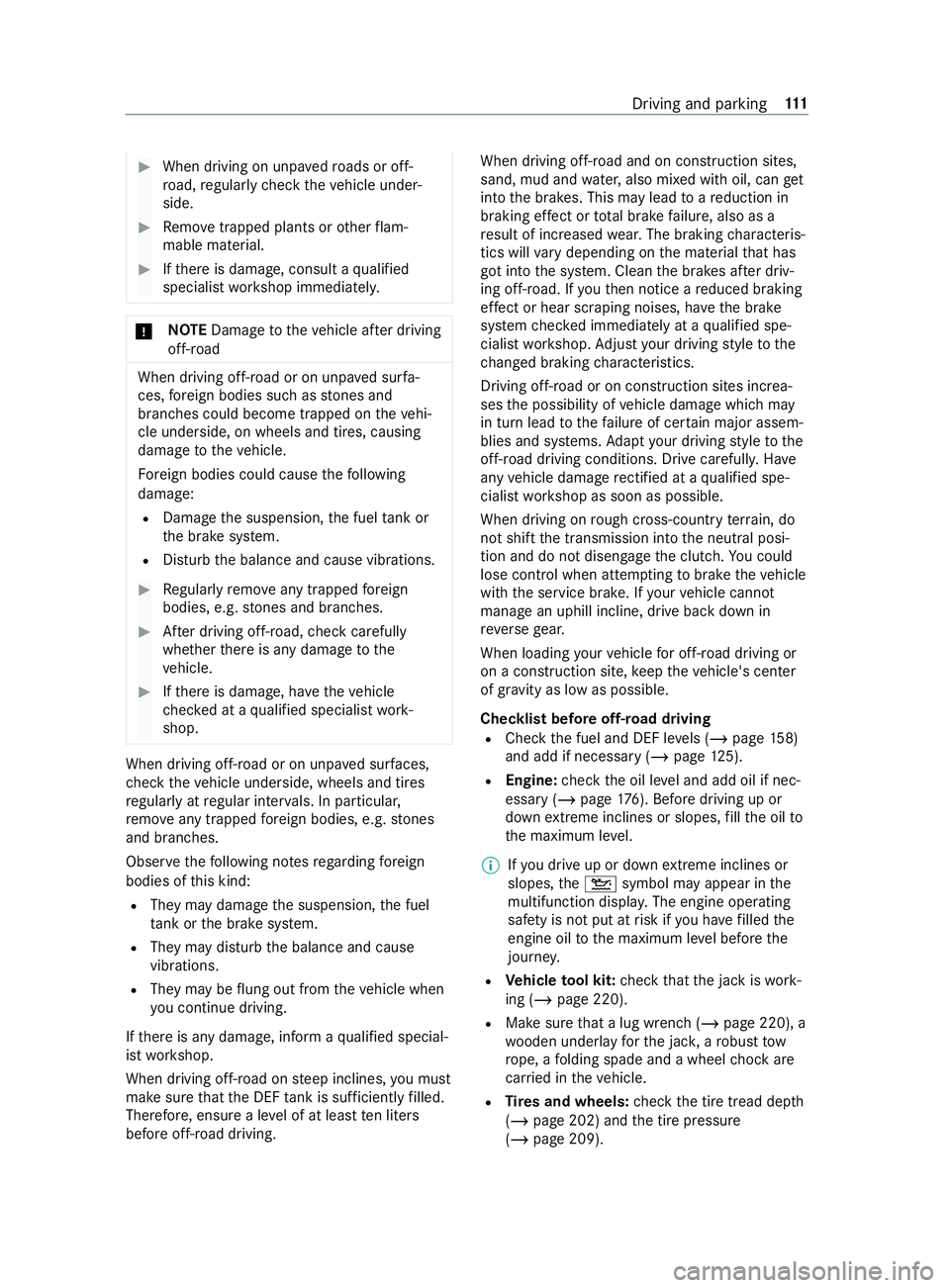
#
When driving on unpa vedr oads or off-
ro ad, regular lych eckt he vehicle under‐
side. #
Remo vetrappe dplants or other flam‐
mable material. #
Ifth er eisd amage, consult aqualified
specialis tworks hop immediately. *
NO
TEDama getothev ehicle af terd riving
off-road When driving off-road or on unpa
veds urfa‐
ces, fore ign bodies suc hasstones and
branches could become trapped on thev ehi‐
cle underside, on wheels and tires, causing
damag etothevehicle.
Fo reign bodies could cause thef ollowing
damage:
R Damag ethe suspension, thef uel tank or
th eb rake system.
R Disturb theb alance and cause vibrations. #
Regular lyremo veanyt rapped fore ign
bodies, e.g. stones and branches. #
Afterd riving off-road, checkc arefully
whe ther ther eisa nydamag etothe
ve hicle. #
Ifth er eisd amage, ha vethev ehicle
ch eckedataq ualified specialis twork‐
shop. When driving off-road or on unpa
veds urfaces,
ch eckt he vehicle underside, wheels and tires
re gularly at regular inter vals. In particular,
re mo veanyt rapped fore ign bodies, e.g. stones
and branches.
Obser vethef ollowing no tesr egarding fore ign
bodies of this kind:
R Theym aydamag ethe suspension, thef uel
ta nk or theb rake system.
R Theym aydisturb theb alance and cause
vibrations.
R Theym aybe flung out from thev ehicle when
yo uc ontinue driving.
If th er eisa nydamage, infor maqualified special‐
is tw orks hop.
When driving off-road on steep inclines, youm ust
mak esuret hat theD EFtank is su fficientl yfilled.
Therefore, ensur ealevelofatl eastten liters
befor eoff-road driving. When driving off-road and on con
stru ction sites,
sand ,mud and water,also mixed wit hoil, can get
int ot he brakes. This ma ylead toareduction in
braking ef fect or total brak efailure, also as a
re sult of increased wear.T he brakin gcharacteris‐
tics will vary depending on them aterial that has
go tint ot he sy stem. Clean theb rake sa fter driv‐
ing off-road. If yout hen notice areduced braking
ef fect or hea rscraping noises, ha vetheb rake
sy stem checkedi mmediately at aqualified spe‐
cialis tworks hop. Adjus tyour driving styletot he
ch anged brakin gcharacteristics.
Driving off-road or on construction sites increa‐
ses thep ossibility of vehicle damag ewhichm ay
in tur nlead tothef ailur eofc ertain major assem‐
blies and sy stems. Adapty our driving styletot he
off-road driving conditions. Driv ecarefull y.Ha ve
an yv ehicle damag erecti fied at aqualified spe‐
cialis tworks hop as soon as possible.
When driving on rough cross-countr yterrain, do
no ts hif tthe transmission int othe neutral posi‐
tion and do no tdisengag ethe clutch. Youc ould
lose control when attem pting tobrak ethe vehicle
wit hthe service brake. If your vehicle cannot
manag eanuphill incline, driv ebackd ownin
re ve rseg ear.
When loading your vehicle foro ff-road driving or
on aconstruction site, keep thev ehicle's center
of gr avity as lo waspossible.
Checklis tbefor eoff-road driving
R Chec kthe fuel and DEF le vels (/ page158)
and add if necessa ry (/ pag e125).
R Engine: checkt he oil le vela nd add oil if nec‐
essar y(/pag e176).Be fore driving up or
down extreme incline sorslopes,fill th eo ilto
th em aximum le vel.
% If
yo ud rive up or down extreme incline sor
slopes, the00B2 symbol ma yappear in the
multifunction displa y.The engine operating
saf etyisn otput at risk if youh ave filled the
engine oil tothem aximum le velb efor ethe
journe y.
R Vehicl etool kit: checkt hat thej ackisw ork‐
ing (/ page220).
R Mak esuret hat alug wrenc h(/pag e220), a
wo oden underla yfor thej ack, ar obus ttow
ro pe, afolding spade and awheel choc ka re
car ried in thev ehicle.
R Tire sa nd wheels: checkt he tir etread dep th
( / pag e202) and thet irep ressure
(/ page209). Driving and parking
111
Page 136 of 322

Ru
les foro ff-road driving
Alw aysbea wareoftheg round clearance of the
ve hicle and avoid obs tacles suc hasdeept ire
ru ts.
Obs tacles can damag ethe following parts of the
ve hicle, fore xamp le:
R Suspension
R Driv etra in
R Fuel and suppl ytanks
Therefore, alw aysd rive slowl ywhen off-road. If
yo um ustd rive ov er obs tacles ,have thec o-driver
instruct you.
% Mercedes-Ben
zrecommends that youa ddi‐
tionall ycarry as hovela nd areco very rope
wit has hackle in thev ehicle.
R Mak esuret hat loadsa nd items of luggage
ar es ecurel ystore dorl ashed down
(/ page72).
R Before driving off-road, stop thev ehicle and
engag ealowgear.
R Vehicles with DSR: activateDSR when you
ar ed rivin gd ownhill (/ page120).
R All-wheel driv evehicles: activatethe all-
wheel driv e(/pag e119)a nd, if necessa ry,
activat ethe LOWR ANGE transmission ratio
(/ page 119).
R Ifth es urface requ ires, temp oraril ydeactivate
ASR when pulling away ( /pag e119).
R Onlydrive off-road wit hthe engine running
and agear engaged.
R Driv eslowl yand smo othly. Wa lkin gpace is
necessar yinmanys ituations.
R Avoid spinning thed rive nw heels.
R Alwayse nsur ethat thew heels remain in con‐
ta ct wi th theground.
R Exercise theu tmos tcaution when driving
across unfamiliar ,unpre dictable terrain. As a
precaution ,get out of thev ehicle totake a
look at ther out etobet akenfirs t.
R Lookoutforo bstacles (e.g .roc ks,h oles, tree
st umps and tir eruts).
R Avoid edges wher ethe sur face could crumble
or brea kaway.
Ru les forf ording off-road (all-wheel drive
ve hicles)
R Obser vethes afet yn otes and general no tes
on driving off-road. R
Chec kthe dep thand characteristic softhe
body of waterbefor efording. The watermust
no tbed eeper than 23.6 in (60 cm).
R The climat econtrol sy stem is switched off
(/ page95).
R The auxiliar yheating is switched off
(/ page100).
R Switc hona ll-wheel driv e(/pag e118)and
engag eitonv ehicles wit hthe LOWR ANGE
transmission ratio (/ page 119).
R Restrict thes hiftrang eto 1or 2.
R Avoid high engine speeds.
R Driv eslowl yand smoo thly at no mor ethan a
wa lkin gpace.
R Ensur ethat no bo wwavef orms while driving.
R Afterf ording, dr ythe brakes.
Af terd riving thro ugh abody of waterdeeper than
19 .7 in (50 cm) ,makes uretoc heckallve hicle
fl uids fora ny signs of penetration bywate r.
Checklis tafter driving off- road
If yo uf ind dama getothev ehicle af tero ff-road
driving, ha vethev ehicle checkedataq ualified
specialis tworks hop immediatel y.
Driving overrough terrain place sgreater
demands on your vehicle than normal road opera‐
tion. Chec kyour vehicle af terd riving on rough
te rrain. This allo wsyoutod etect damage
prom ptly and reduce ther isk of an accident for
yo urself and other road users. Clean your vehicle
th oroughly befor edriving on public roads.
Obse rvet he following point safter drivin goff-
ro ad, on con stru ction sites and befor edriving on
publi croads:
R Vehicles with DSR: deactivateDSR
(/ page120).
R All-wheel driv evehicles: deactivat ethe all-
wheel driv e(/ pag e119).
R Activat eASR (/ page 119).
R Clean thee xterio rlighting, particular lythe
headlamp sand tail lamps, and checkt hem
fo rd ama ge.
R Clean thef ront and rear licens eplates.
R Clean thew indshield, windo wsand outside
mir rors.
R Clean thes teps, entra nces and grab handles.
Thi sincreases thes afet yofy ourfoot ing.
R Clean thew heels and tires, wheel wells and
th eu nderbody of thev ehicle wit hawater jet. 11 2
Driving and pa rking
Page 138 of 322
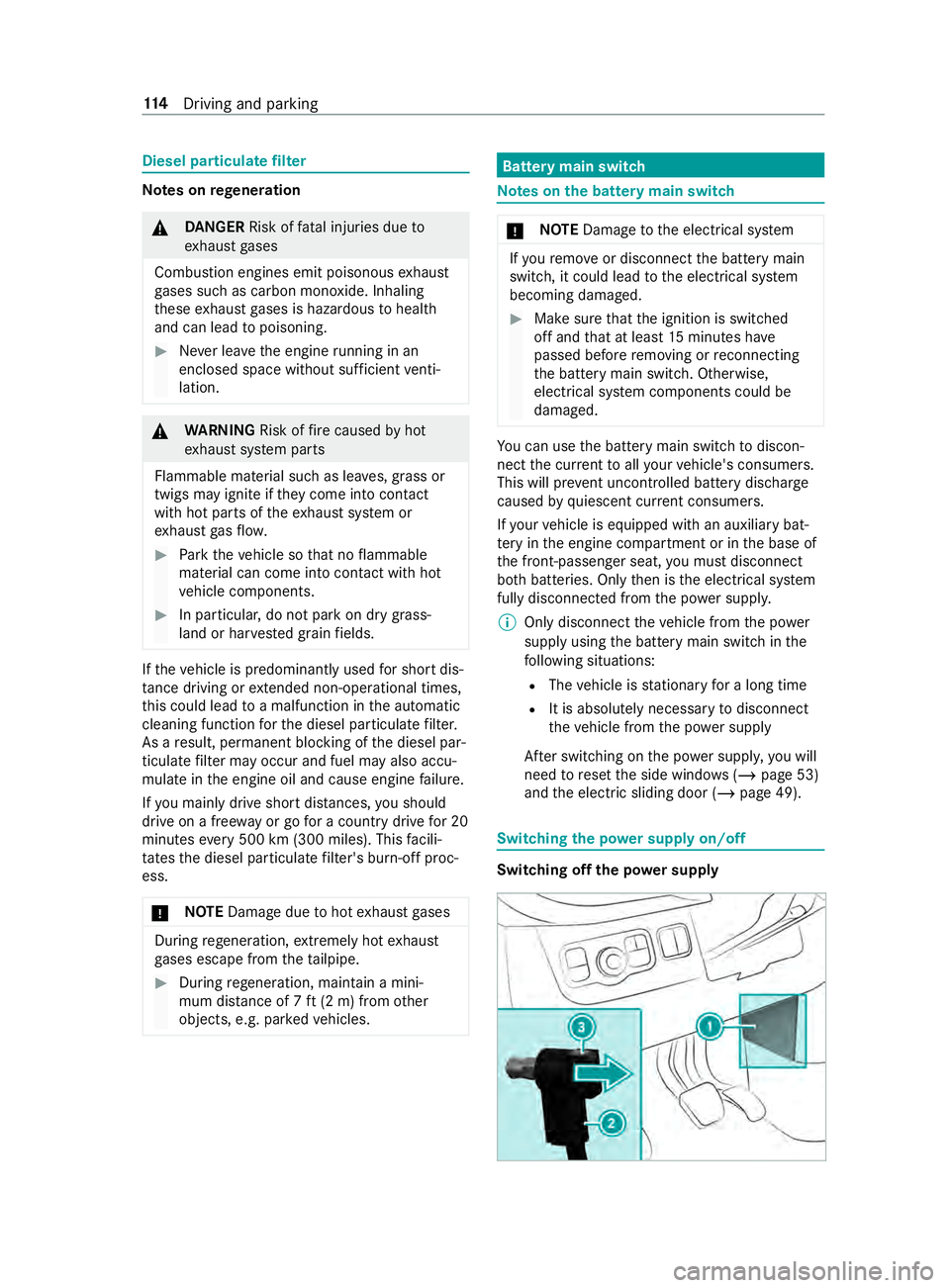
Diesel pa
rticulat efilter Note
sonr egeneration &
DANG ER Risk of fata linjuries due to
ex haus tgases
Combustio nengines emit poisonous exhaust
ga ses suc hascarbon monoxide. Inhaling
th ese exhaus tgases is hazardou stohealth
and can lead topoisoning. #
Neverlea ve thee ngine running in an
enclose dspace wi thout suf ficient venti‐
lation. &
WARNING Risk offire caused byhot
ex haus tsystemp arts
Flammable material suc hasleaves, grass or
twigs ma yignit eift heyc ome int ocontact
wi th hotp arts of thee xhau stsystem or
ex haus tgas flow. #
Park thev ehicle so that no flammable
material can com eintoc ontact wi thhot
ve hicle components. #
In particular ,donotpar kond rygrass‐
land or har vested grain fields. If
th ev ehicle is predominantl yused fors hor tdis‐
ta nce driving or extende dnon-operationa ltimes,
th is could lead toam alfunctio ninthe automatic
cleaning function fort he diesel particulat efilter.
As aresult, permanent blocking of thed iesel par‐
ticulat efilter ma yoccur and fuel ma yalso accu‐
mulat einthe engine oil and cause engine failure.
If yo um ainlydriv eshor tdistan ces, yous hould
driv eonaf reew ay or go forac ountr ydrive for20
minutes every500 km (300 miles). This facili‐
ta test he diesel particulat efilter's burn-of fproc‐
ess.
* NO
TEDama gedue tohote xhau stgases During
rege neration, extremely ho texhau st
ga ses escape from thet ailpipe. #
During rege neration, maintai namini‐
mum di stanc eof7ft(2m)f romo ther
objects, e.g. par kedv ehicles. Batter
ymain switch Note
sont he batter ymain switch *
NO
TEDama getothee lectrical sy stem If
yo ur emo veor disconnect theb atter ymain
switch, it could lead tothee lectrical sy stem
becomin gdamaged. #
Mak esuret hat thei gnition is switched
of fa nd that at leas t15minutes ha ve
passed befor eremoving or reconnecting
th eb atter ymain switch. Otherwise,
electrical sy stem components could be
damaged. Yo
uc an use theb atter ymain switc htodiscon‐
nect thec urrent toall your vehicle's consumers.
This will pr event uncontrolle dbattery discha rge
caused byquiescent cur rent consumers.
If yo ur vehicle is equipped wit hanauxiliary bat‐
te ry inthee ngine compartmen torinthe base of
th ef ront-passen gers eat, youm ustd isconnect
bo th batteries. Onl ythen is thee lectrical sy stem
fully disconnected from thep ower supply.
% Only disconnect thev ehicle from thep ower
supply using theb atter ymain switc hinthe
fo llowing situations:
R The vehicle is stationar yfor along time
R It is absolutely necessar ytodisconnect
th ev ehicle from thep ower supply
Af ters witching on thep owe rsupp ly,y ou will
need torese tthe side windo ws (/pag e53)
and thee lectric sliding door (/ page49). Switching
thep owe rsuppl yon/off Swit
ching of fthe po wersupply 11 4
Driving and pa rking
Page 139 of 322
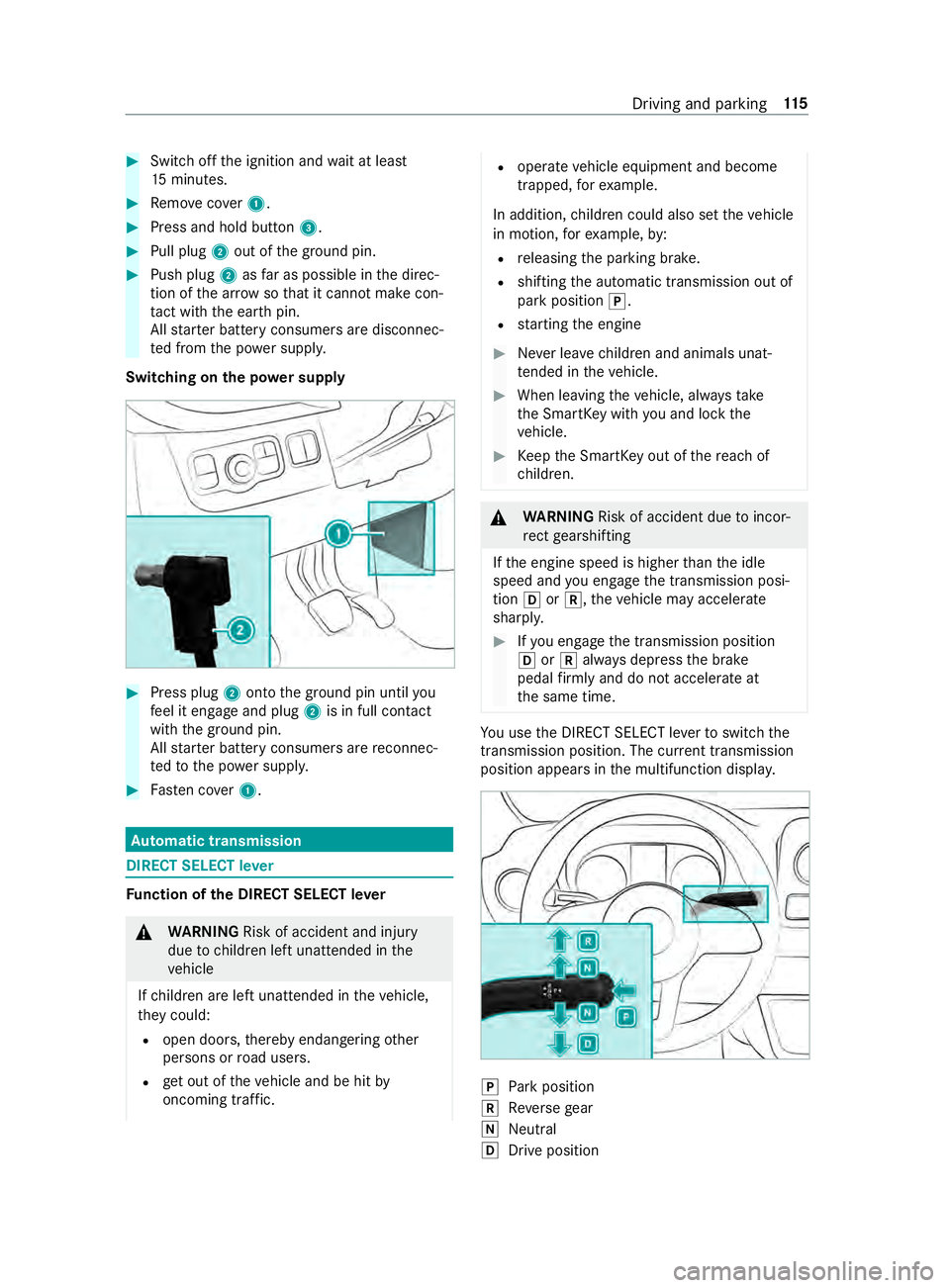
#
Switc hoffthei gnition and wait at least
15 minutes. #
Remo vecover 1. #
Press and hold button 3.#
Pullp lug2out of theg round pin. #
Push plug 2asfarasp ossible in thed irec‐
tion of thea rrow sothat it canno tmakec on‐
ta ct wi th theearth pin.
All star terb atter yconsumer saredisconnec‐
te df romt he po wersupp ly.
Switching on thep owe rsupply #
Press plug 2ontothe ground pin until you
fe el it engag eand plug 2is in full contact
wit hthe ground pin.
All star terb atter yconsumer sarereconnec‐
te dtot he po wersupply. #
Fasten co ver1. Au
tomatic transmission DIREC
TSELECT lever Fu
nction of theD IRECT SELECT le ver &
WARNING Risk of accident and inju ry
due tochildren lef tunat tende dint he
ve hicle
If ch ildren ar eleftu nat tende dint hevehicle,
th ey could:
R opendoors,t hereb yendangering other
persons or road users.
R geto utofthev ehicle and be hit by
oncomin gtraffic. R
operat evehicle equipment and become
trapped, fore xamp le.
In addition ,children could also se tthe vehicle
in motion, fore xamp le,by:
R releasing thep arking brake.
R shifting thea utomatic transmission out of
par kposition 005D.
R startin gthe engine #
Neverlea ve children and animals unat‐
te nde dint hevehicle. #
When leaving thev ehicle, alw ayst ake
th eS martK eywit hyou and loc kthe
ve hicle. #
Keep theS martK eyout of ther eac hof
ch ildren. &
WARNING Risk of accident du etoincor‐
re ct gearshifting
If th ee ngine speed is higher than thei dle
speed and youe ngag ethe transmission posi‐
tion 005Bor005E,t hevehicle ma yaccelerate
sharply. #
Ifyo ue ngag ethe transmission position
005B or005E alwaysd epress theb rake
pedal firm lyand do no taccelerat eat
th es ame time. Yo
uu setheD IRECT SELECT le vertos witchthe
transmission position. The cur rent transmission
position appear sinthe multifunction displa y. 005D
Park position
005E Reverseg ear
005C Neutral
005B Driveposition Driving and pa
rking 11 5
Page 140 of 322
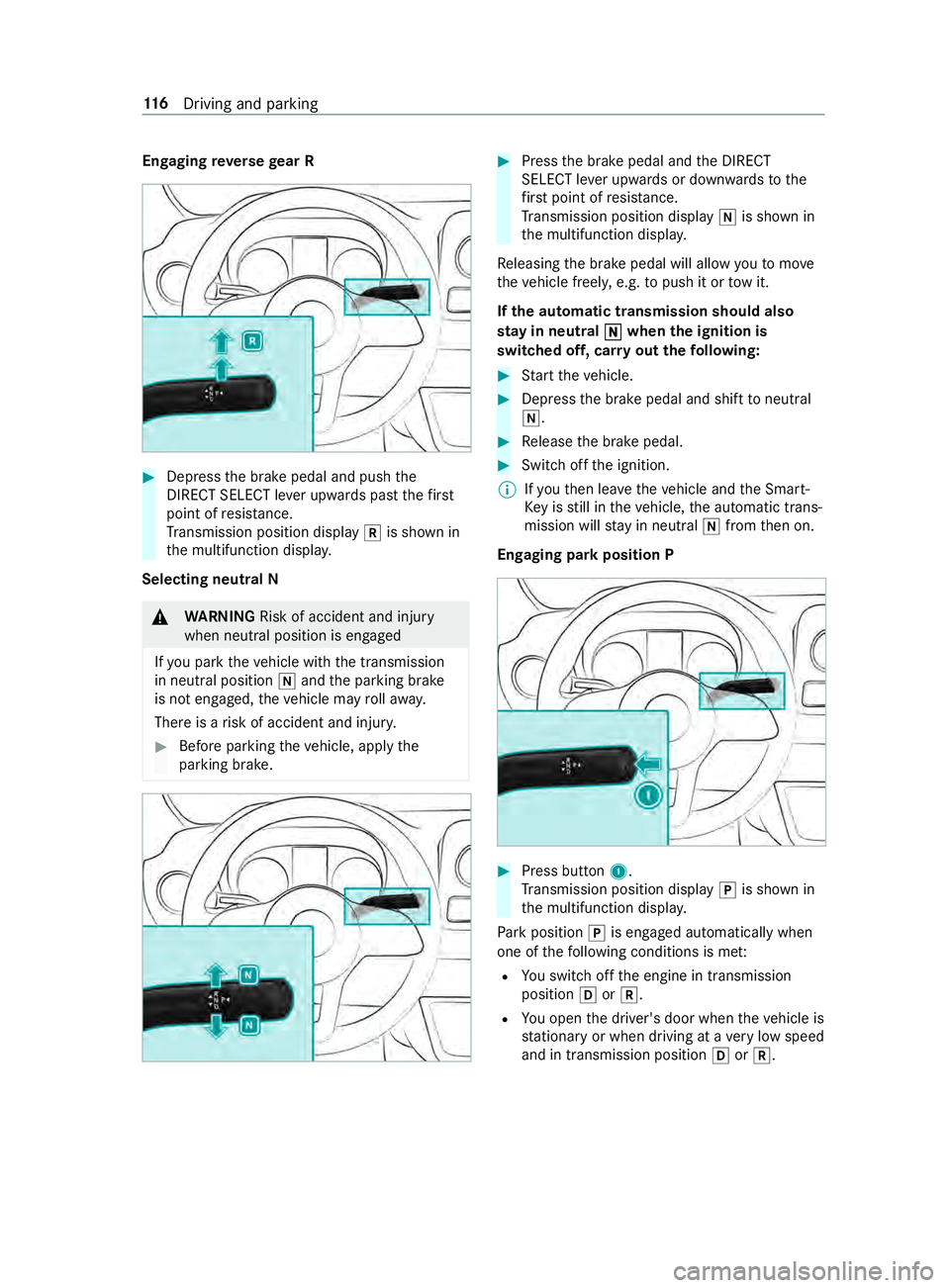
Engaging
reve rseg ear R #
Dep ress theb rake pedal and push the
DIRECT SELEC Tleve rupwards pas tthe first
point of resis tance.
Tr ansmission position display 005Eis shown in
th em ultifunction displa y.
Selecting neutral N &
WARNING Risk of accident and inju ry
when neut ralp osition is engaged
If yo up arkt he vehicle wit hthe transmission
in neutral position 005Cand thep arking brake
is no tengaged, thev ehicle ma yroll away.
Ther eisar isk of accident and injur y.#
Befor eparkin gthe vehicle, apply the
parking brake. #
Press theb rake pedal and theD IRECT
SELECT le veru pwards or down wardstot he
fi rs tp oint of resis tance.
Tr ansmission position display 005Cis shown in
th em ultifunction displa y.
Re leasing theb rake pedal will allo wyoutomo ve
th ev ehicle freely ,e.g. topush it or towi t.
If th ea utomatic transmission should also
st ay in neutral 005C 005Cwhen thei gnition is
switched off, car ryout thef ollowing: #
Startt he vehicle. #
Depress theb rake pedal and shif ttoneutral
005C. #
Release theb rake pedal. #
Switc hoffthei gnition.
% If
yo ut hen lea vethev ehicle and theS mart‐
Ke yiss tillint hevehicle, thea utomatic trans‐
mission will stay in neut ral005C from then on.
Engaging par kposition P #
Press button 1.
Tr ansmission position display 005Dis shown in
th em ultifunction displa y.
Pa rk position 005Dis engaged automaticall ywhen
one of thef ollowing condition sismet:
R Yous wit ch offt he engine in transmission
position 005Bor005E.
R Youo pen thed rive r's door when thev ehicle is
st ationar yorwhen drivin gataveryl ow speed
and in transmissio nposition 005Bor005E. 11 6
Driving and pa rking